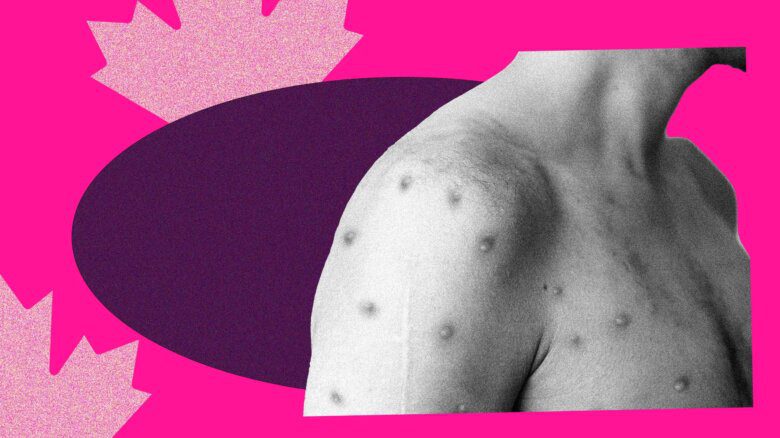When you know yourself to be a person with a flat chest and a bulge in your pants, looking in the mirror and seeing breasts and a flat crotch can feel excruciating. It’s so obvious that clothes just don’t fit the way they should, that something is wrong.
If you wish you didn’t have breasts—or just wish they were smaller, sometimes—you may consider binding. And if you wish you had a dick and balls—or just want to know what it’s like to walk through the world with a bulge in your pants—you may consider packing.
Binding is flattening your breasts into a lower chest profile. Binding materials include sports bras, tape and specialty garments called binders.
Packing is putting something in your underwear to create the appearance of a dick and balls—the simplest item is a pair of rolled-up cotton socks, but there are also soft penile prosthetics called packers. Some packers also double as stand-to-pee devices that make urinals accessible to folks with vulvas.
Both binding and packing are common among many trans men, non-binary people and drag performers. You might want to pack or bind to feel more at home in your body, to lessen gender dysphoria or to draw less attention to yourself in public spaces.
Katherine Gardner is a queer physician in Sacramento, California, who cares for many people who bind and pack. Xtra asked Gardner to walk us through the most common questions she gets from patients.
On binding
What should I use to bind?
I tell my patients that binding is something that’s supposed to make you feel good; what that means depends on you as a person.
I’ll usually talk about a few different kinds of binding. For really simple binding, where maybe they already have the supplies at home, they can use a very tight fitting sports bra or two. Sometimes people will even use an elastic bandage and tape. Then we’ll talk about what a binder is and how to find a binder—we’ll also talk about how to pay for one, since insurance doesn’t cover binders.
Some websites have said that binding with elastic bandages like Ace Wrap could cause injury, since they allegedly tighten as you move.
That’s not true. That’s not how Ace Wraps work. They don’t tighten as you expand and contract. They are just tools for binding.
In fact, one of the problems with ace wraps is that they loosen over time. I often dispense an Ace Wrap at my clinic if someone sprains their ankle. I’ll tell them: “This is going to last you three days, because it’s going to get stretchy and worn out.”
And, in theory, an Ace Wrap may be easier to get out of more quickly than some other types of binding. If there was ever a concern that you had boa constricted yourself, you could get out of an Ace Wrap pretty quickly.
What’s the difference between a short and a long binder?
If you have a binder that goes all the way down to your hips, your belly isn’t going to be able to expand as much when you take deep breaths. I find that people have such different experiences with their chests: The choice of a long or short binder is very individual, because it depends on what the person is wanting to get out of it.
Can I exercise while binding?
Whether it’s exercise, walking up 10 sets of stairs because you have to get somewhere, sex or any kind of exertion, everybody has a different tolerance. Everybody needs a different amount of chest wall expansion to do those things, everybody needs a different tightness of the binder that they’re wearing; there isn’t a blanket rule about it.
The important thing is that your body is getting enough oxygen so that you’re not passing out. Where that line is is different for every single person. Most people have a sense of when they should be stopping—we do this naturally when we’re exercising. If you’re going on a treadmill, you have a sense of, “Well, I probably shouldn’t push myself any further.”
So yes, you can exercise in a binder, but you want to pay attention to your body’s signals when you do. That’s going to be a bit of a learning process if you’re someone who exercised previously without a binder.
What are the possible harms of binding?
From a medical perspective, the question about binding and any kind of intervention on your body is the cost of it versus its benefits.
A binder is tight. That’s just its nature. When something is tight around your chest, the chest wall doesn’t always fully expand when you’re taking deep breaths, which can really limit your ability to breathe heavily and deeply. And so sometimes it can interfere with the amount of exercise you would do. You need to listen to your body and you need to not pass out; if you are exercising to the point where you’re not really able to talk to somebody, that’s too much. It’s a sign that you don’t have any extra room.
However, it’s weighed against the benefits that the person binding is getting. Maybe they experience a lot of distress with the presence of breast tissue on their chest and they wouldn’t be exercising if they weren’t binding.
In terms of someone’s overall health and well-being, breathing deeply has never been high on my list of concerns compared to someone’s mental health and distress and ability to function in their day-to-day life. If someone is binding, then it’s important to them. If binding helps a kid or an adolescent attend class and not be totally distracted, that’s important. If binding decreases self-harm, that’s so important.
How do I take care of my skin while binding?
There can be skin irritant reactions due to binding. There’s something that looks a little bit like eczema called contact dermatitis; that can come from the type of material the binder is, an allergy to that particular material or even the soap that you’re washing it in. If it’s the soap, you’ll have to do some research and figure out what it is to change it, or the irritation will keep coming back.
Fungal infections are also common. That’s because the chest area is going to be really tight and warm and people get sweaty, especially in the summer when it’s hot or if they’re even mildly exerting themselves—a perfect environment for fungus. In that case, I tell people to make sure their binding materials are washed in hot water, and give them a topical antifungal to use—usually a cream or powder.
If you’re noticing your binder is moist or wet and you have spare binders and the option to change the one you’re wearing, I would try to change it. But if you don’t have multiple binders, then you just wear the one you have.
How do I know if I’m binding for too long? Where do I draw the line?
It’s not like there’s a one size fits all. Again, it’s about weighing those costs versus the benefits. I advise people to think about what they want and need to do, and whether binding helps them do those things. For some folks it might be, “I need to get out and go to the grocery store.” For others it might be, “I need to get out of bed and do my usual day around my home.”
Different people have different situations where binding is helpful. It’s absolutely important to get out of bed and go around your house and do the things that you need to do. Binding, in that case, would be important to do as soon as the person is able to and for as long as they’re able to.
How do I know if my binder is too tight?
There are different tightnesses of binders. Go to the tightness that you need to feel comfortable, but make it the least tight that you need to be comfortable.
Am I going to break my ribs?
I have never seen that. I’ve taken care of lots of patients, and I can’t imagine a scenario where that would happen. Binding is a slow, steady pressure, not a trauma impact. And unless somebody had something else going on with their body, like a condition where someone has brittle bones, it’s highly unlikely.
Can I still bind if I have asthma?
Yes. Asthma is a problem within the lungs, it’s not a problem with actual expansion of the chest cavity. Comfort in terms of being able to breathe adequately is really important for anybody, whether or not they have asthma or breathing issues. It’s about weighing the costs and benefits, and finding the amount of binding that is enough for you to do what’s important to you.
Am I going to hurt my back?
You could. If you’re exercising less and you have less muscle tone, then you have less muscle conditioning—which makes you more likely to have injuries, particularly back injuries. So in that sense, yes. But as a direct consequence of binding the chest, no.
That said, as we think about binding lower down on the abdomen toward the hip bones, it’s more analogous to a back brace. Sometimes a back brace can make it more likely that somebody will get a back injury because the muscles will weaken. I try to recommend a back brace only if someone absolutely needs it.
At what point is binding no longer enough?
I do think if somebody is experiencing some significant limitations with their binder—as in they’re needing to bind all the time and they’re like, “Holy moly, I really can’t exercise. I want to have active muscles and an active body, and I can’t really do that in the way that I want to be when I’m binding”—then that’s a good reason to have a conversation about top surgery.
In an ideal world, someone who needs top surgery for gender affirmation would be able to access it as soon as needed. However, waiting time for top surgery can take quite a while. Binding can be a way to make it through until a person is able to access top surgery—it can be extremely important to mitigate the impact of gender dysphoria on a person’s mental health, functioning in life and overall well-being.
When should I consider puberty blockers?
If there’s a youth coming in shortly after they’ve started being exposed to higher levels of estrogen in their body and maybe they don’t have a lot of breast tissue yet but they’re really stressed out about it, we should definitely do puberty blockers.
Young people now are empowered with a lot of knowledge. It’s phenomenal. And they’re able to have conversations about themselves and their bodies in ways that I just think is wonderful. So yeah, do we need to be blocking hormones? Do we need to be adding testosterone? What’s the right answer here? It depends on the person and the parent—and their insurance, which is the most frustrating thing ever.
Is there any harm in terms of their growth?
I sometimes get questions from parents of young teens—kids who still have some growth left to do in their bones and their chest wall. Parents have a concern about binding interfering with growth. And the honest answer is: I don’t know. We go back to the basics. One: People bind for a lot of different reasons. When it’s to help them with just doing their life, there is tremendous benefit to binding. Two: The potential cost of not binding can be life threatening for people. In that case, the costs of binding aren’t as much as the benefits from binding. And so I talk about that.
I also tell them it’s important to reassess binder size pretty regularly, especially for youths that are still growing. If you’ve grown and a binder is too tight, is there any room to loosen up a little bit or get a bigger size?
And then I ask, “Are there times that are okay for you to be out of the binder?” If the answer is “Not right now,” then I ask if there is a way that home can be made a safer space. For example, the whole family can consistently use correct pronouns, take down pictures, change certain art, move mirrors. Sometimes just making those changes can make someone feel more comfortable being out of their binder.
On packing
Can I wear my packer during a CT scan?
It depends on where in the body the CT scan is going to be, and what you’re packing with. Cotton socks are way more CT compatible than some other things.
Do I need a letter to go through airport security while packing?
No. In the U.S., there isn’t a formal letter for the Transportation Security Administration (TSA)—it’s not like TSA has come up with letters. But sometimes patients ask me to write a letter they can show to TSA agents going through, in the hopes of curtailing harassment. I’m happy to do that if somebody asks for it.
I’m a teenager. How do I talk about packing with my doctor?
Adolescence is such an embarrassing time. A lot of kids are like, “I don’t want to be talking about my sore throat with my parents around, let alone packing.”
Most often it first comes up with the kid by themselves. I’ll usually say, “Okay, so do you pack, or do you know what packing is?” And then if they don’t know we’ll talk about it. Or if they do pack, I’ll ask, “What do you do to pack? What times is it helpful? Do you like it? Are there other ways you’re thinking of packing that would be helpful for you?” And they’re like, “Yeah, I’d really like to buy this, but it’s a ridiculous amount of money. I don’t have it. But maybe my parents do.” And I’ll say, “Okay, what if we talked to your parents about it?”
Beyond the standard advice on how to choose a packer, do you have any guidance on what materials to choose or avoid? For example, some packers are made of silicone, others aren’t.
In terms of materials, definitely nothing with latex close to the skin. It’s just so common for people to develop a latex allergy that you really want to avoid prolonged contact with latex, if you can, even if you don’t have an allergy.
What about doing other activities while packing like sleeping, exercising, walking, running, swimming?
Think about the different types of packing that you can do for different situations: maybe it’s a silicone packer for swimming, and if you’re in regular street clothes afterwards just something simple, like rolled-up socks. If you have a variety of options, you can pick what feels good at the time. It actually is pretty simple: Pack with something that’s comfortable and will stay in place with whatever you’re doing. Then listen to your body—if you are getting skin irritation, change what you’re doing.
If I use a stand-to-pee device, am I going to have pee stuck to me after using it?
The pricier ones are better. If you don’t wash it out, there will be some urine that’s left in there. It could smell at some point. If urine stays closer to your body, it could get really irritated. You can imagine a baby in a diaper: Where their skin is in contact with their own urine, they get a rash. Urine is alkaline and that can irritate the skin. Just clean it out as much as you can, when you can.
Does it matter if the packer is right next to my skin or in a pouch?
If your packer is going to be next to groin tissue for a while, be as kind to your groin as you can. That usually means cotton underwear because it’s more breathable. Our groin tissue can be irritated very easily due to changes in the growth of the yeast and bacteria that is normally there. When changes in that growth happen, it can cause yeast infections and other issues. If you can, try to have a piece of cotton between you and a non-cotton packer.
What would be the ideal packing underwear?
Billowy! I’m dreaming here. That’s a design challenge for someone.
This interview has been edited for length and clarity.


 Why you can trust Xtra
Why you can trust Xtra


